Performance Enhancement of Radial Power Distribution Networks Using Network Reconfiguration and Optimal Planning of Solar Photovoltaic-Based Distributed Generation and Shunt Capacitors
Abstract
:1. Introduction
1.1. Network Reconfiguration
- It augments the voltage profile and reliability of the distribution network;
- It avoids congestion in the feeder lines during peak load conditions;
- It helps to restore the power supply when a fault occurs within the distribution network.
1.2. Shunt Capacitor Placement
1.3. Distributed Generation Placement
1.4. Combined Loss Reduction Methods
1.5. Motivations
2. Problem Formulation
2.1. Formulation of Objective Function
2.1.1. Constraints
Power Balance
Rating and Quantity of SC
Node Voltage
Line Flow Limits
Sizing of DG Units
2.2. Radial Configuration
Directed Graph
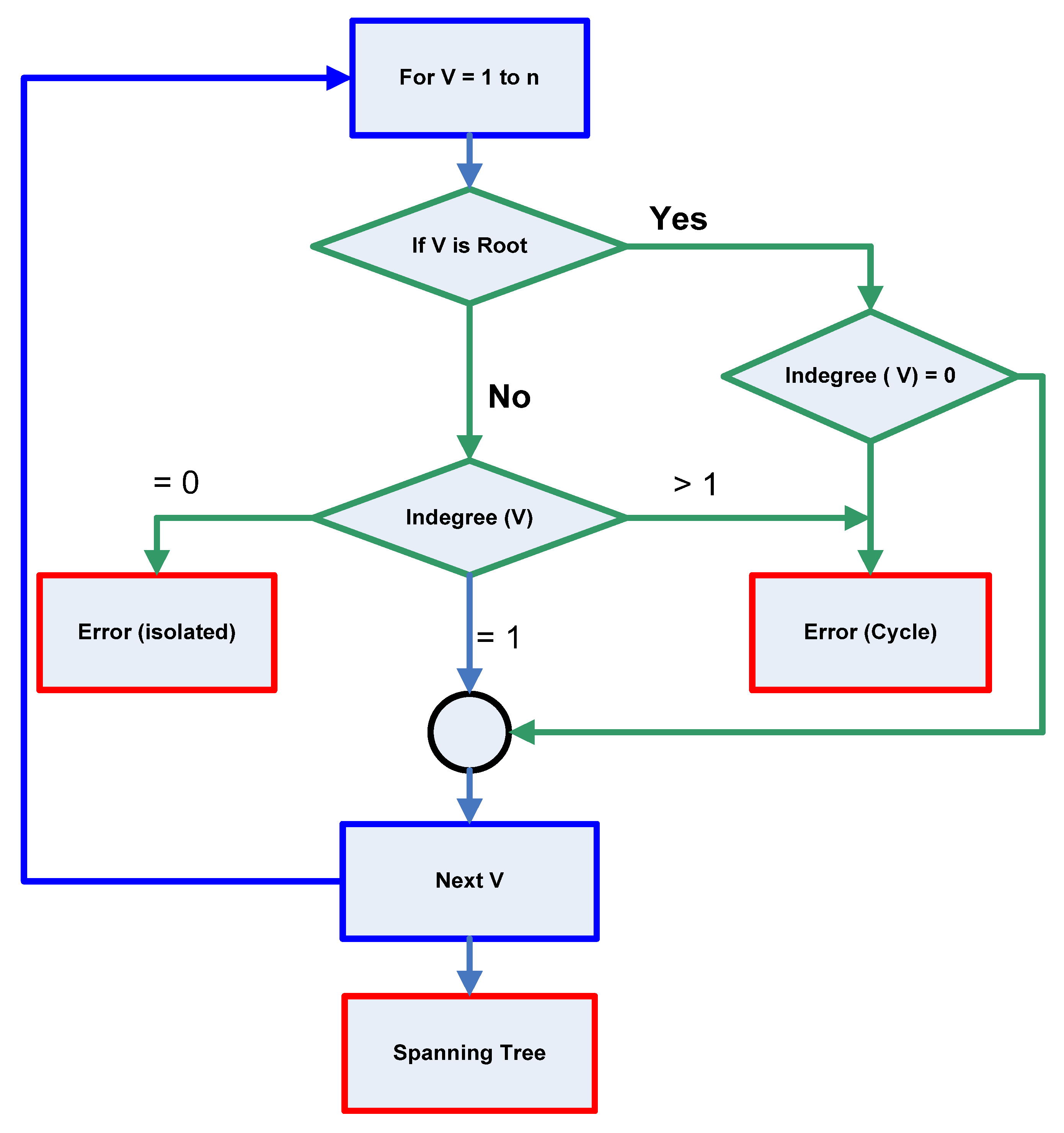
- Step 1: Compute the adjacency matrix (auv) for the RPDN,
- Step 2: Create the directed graph with the help of the bio-graph (bg) function in Matlab based on the adjacency matrix (auv),
- Step 3: Trace the directed graph to form the BIBC matrix by using depth-first search (DFS) order,
- Step 4: Formulate the branch current matrix [BCM] using the (Equation (16))
- Step 5: The voltage drop in each branch of the network is obtained using Equation (17)
3. Hybrid HSA—PABC
3.1. Overview of HSA
Proposed HSA—PABC Algorithm
- Step 1: Initialize the tuning parameters: HMS, PAR, HMCR, SBL, MCNspecified.
- Step 2: Initiate the HMV with random populations.
- Step 3: Update MCN = MCN + 1.
- Step 4: The random populations stored in the HMV are improved by the employed bee of the PABC algorithm using Equation (23).
- Step 5: The new food source location Xjknew is computed by the onlooker bee based on the best fitness probability (Equation (26))
- Step 6: The scout bee replaces the abandoned solution with a new random solution populated using Equation (27):
- Step 7: Preserve the better optimal solution in HMV.
- Step 8: HSA steps for updating HMV:
- Perform the improvisation steps for decision variables stored in the HMV using HMCR, and PAR using Equations (21) and (22).
- Step 9: Calculate the new HMV and update HMV if it is better than the existing one.
- Step 10: Update MCN = MCN + 1.
- Step 11: Verify whether the specified MCN total has been reached.
- Step 12: If not, rerun from Step 4 until MCN = MCNspecified.
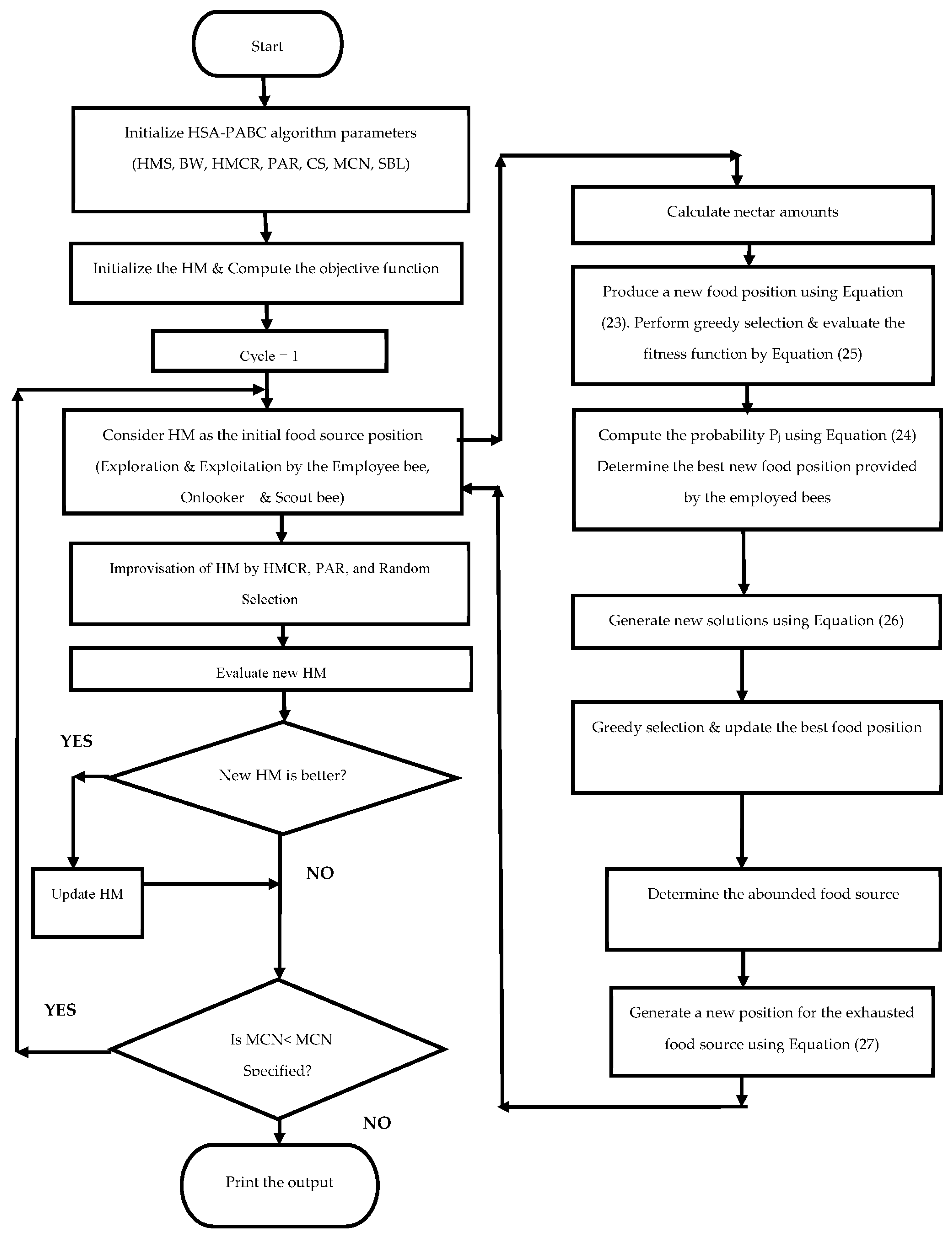
4. Results and Discussion
- Scenario-I: System with base case radial topology.
- Scenario-II: System with optimal reconfiguration topology.
- Scenario-III: Placement of SCs at the potential nodes in base case topology.
- Scenario-IV: Placement of solar PV-DG units at the potential nodes in base case topology.
- Scenario-V: Placement of solar PV-DG units and SCs at the potential nodes in base case topology.
- Scenario-VI: Placement of SCs at the candidate nodes in optimal reconfiguration topology.
- Scenario-VII: Placement of solar PV-DG units at the potential nodes in optimal reconfiguration topology.
- Scenario-VIII: Placement of solar PV-DG units and SCs at the potential nodes in optimal reconfiguration topology.
4.1. Performance of the Networks before and after Network Reconfiguration (Scenarios I–II)
4.1.1. 69 Node RPDN


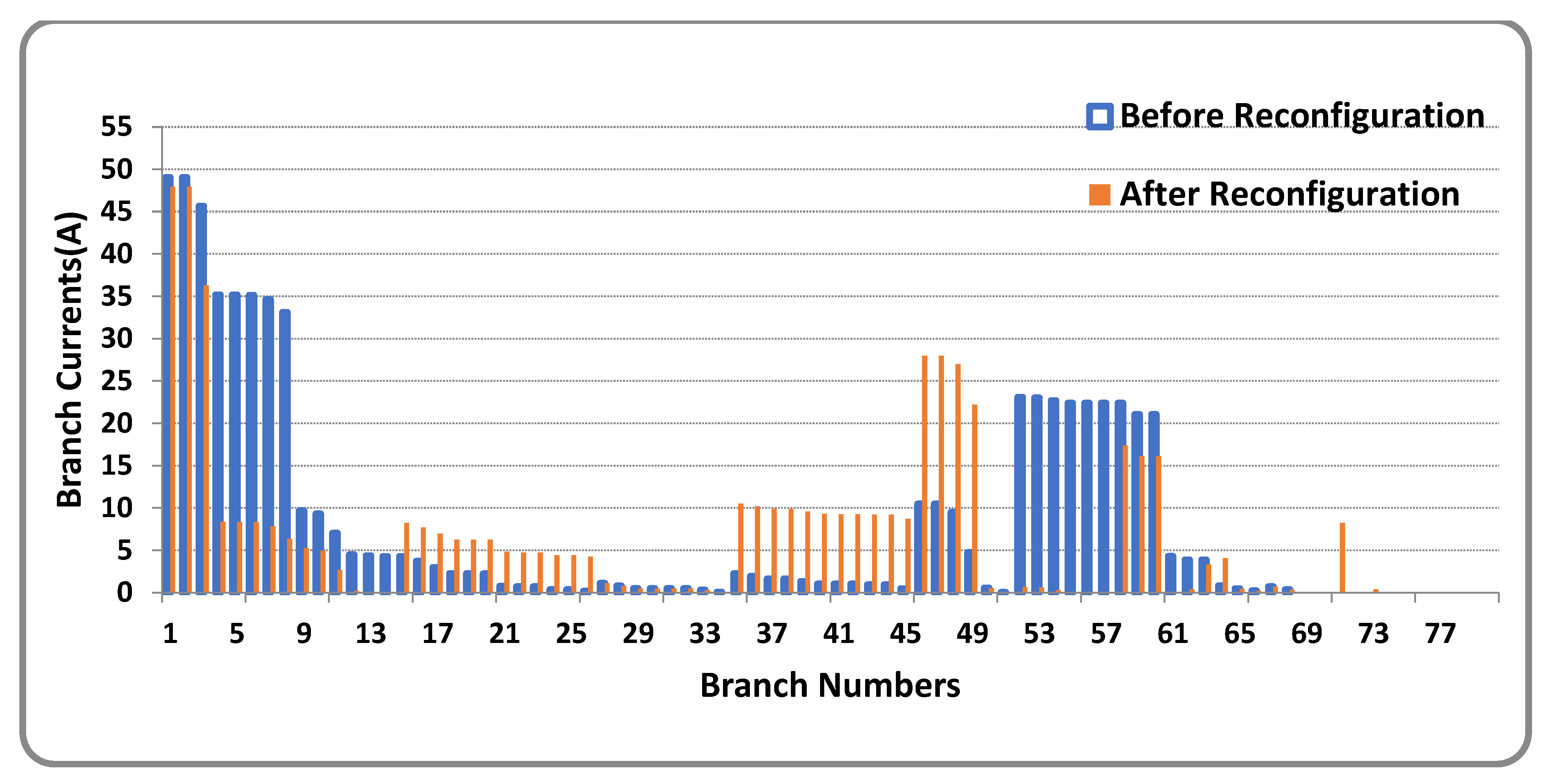
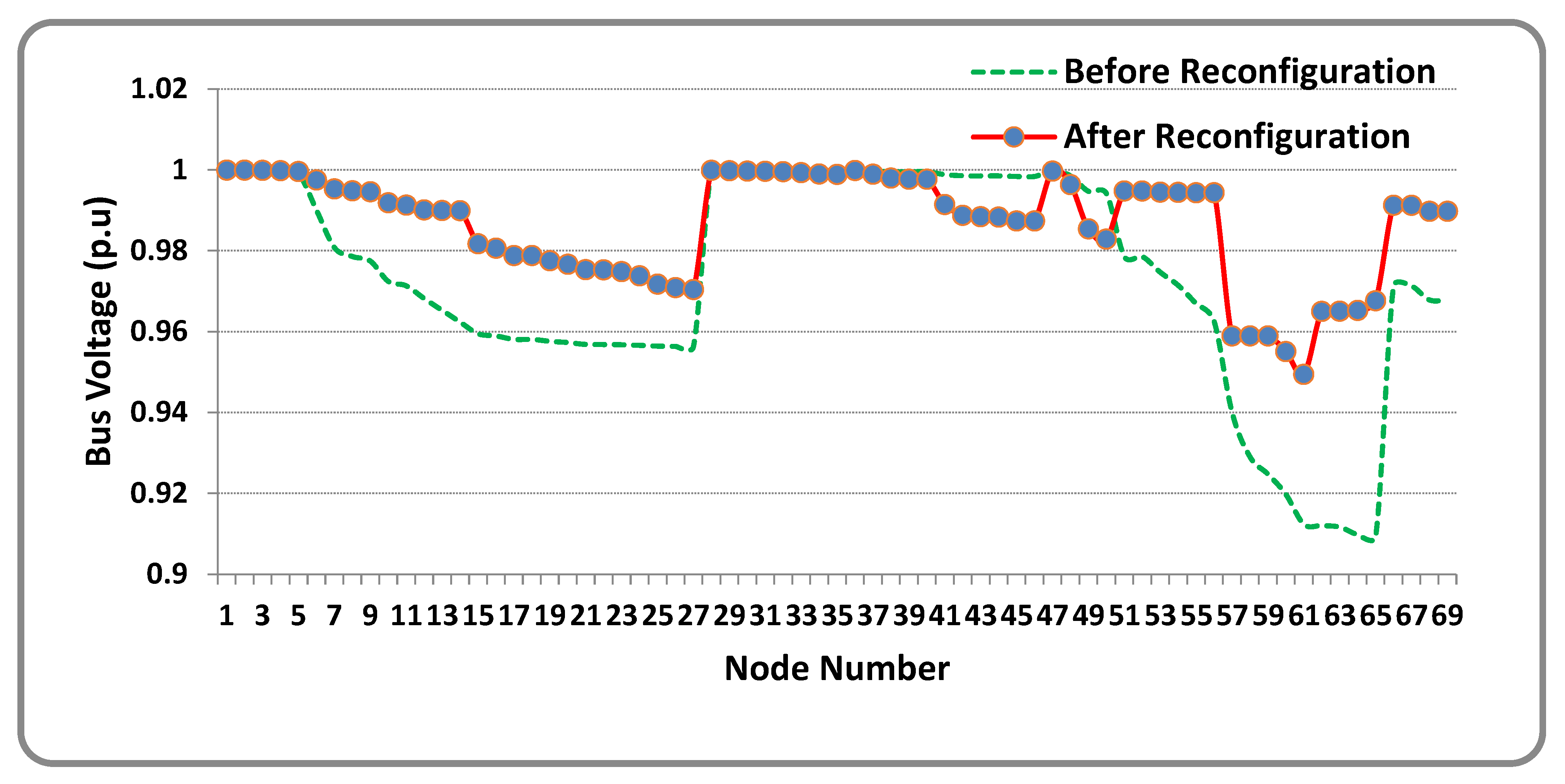
| Scenario | Item | 50% Load | 100% Load | 160% Load |
|---|---|---|---|---|
| Base case radial topology (Scenario-I) | Open switches | 69-70-71-72-73 | 69-70-71-72-73 | 69-70-71-72-73 |
| Ploss in kW | 51.59 | 224.97 | 652.41 | |
| Vmin in p.u (Node) | 0.9566 (65) | 0.9092 (65) | 0.8445 (65) | |
| Optimal radial topology (Scenario-II) | Open switches | 14-56-61-69-70 | 14-56-61-69-70 | 14-56-61-69-70 |
| Ploss in kW | 23.60 | 98.63 | 267.07 | |
| Vmin in p.u (Node) | 0.9753 (61) | 0.9493 (61) | 0.9165 (61) | |
| % Loss reduction | 54.25 | 56.16 | 59.06 |
| Method | Open Switches | Total Power Loss (kW) | % Loss Reduction | Vmin (p.u) |
|---|---|---|---|---|
| Base Topology | 69-70-71-72-73 | 224.97 | - | 0.9092@65 |
| HSA [53] | 69-70-14-53-61 | 103.29 | 54.08 | 0.9411 |
| Enhanced GA [54] | 15-59-62-70-71 | 99.62 | 55.97 | - |
| Non-revisiting GA [55] | 14-58-61-69-72 | 99.62 | 55.97 | 0.9428@50 |
| Adaptive GA [56] | 15-58-62-70-71 | 99.60 | 55.72 | 0.9428@61 |
| Proposed HSA–PABC | 14-56-61-69-70 | 98.63 | 56.16 | 0.9493@61 |
4.1.2. 118 Node RPDN
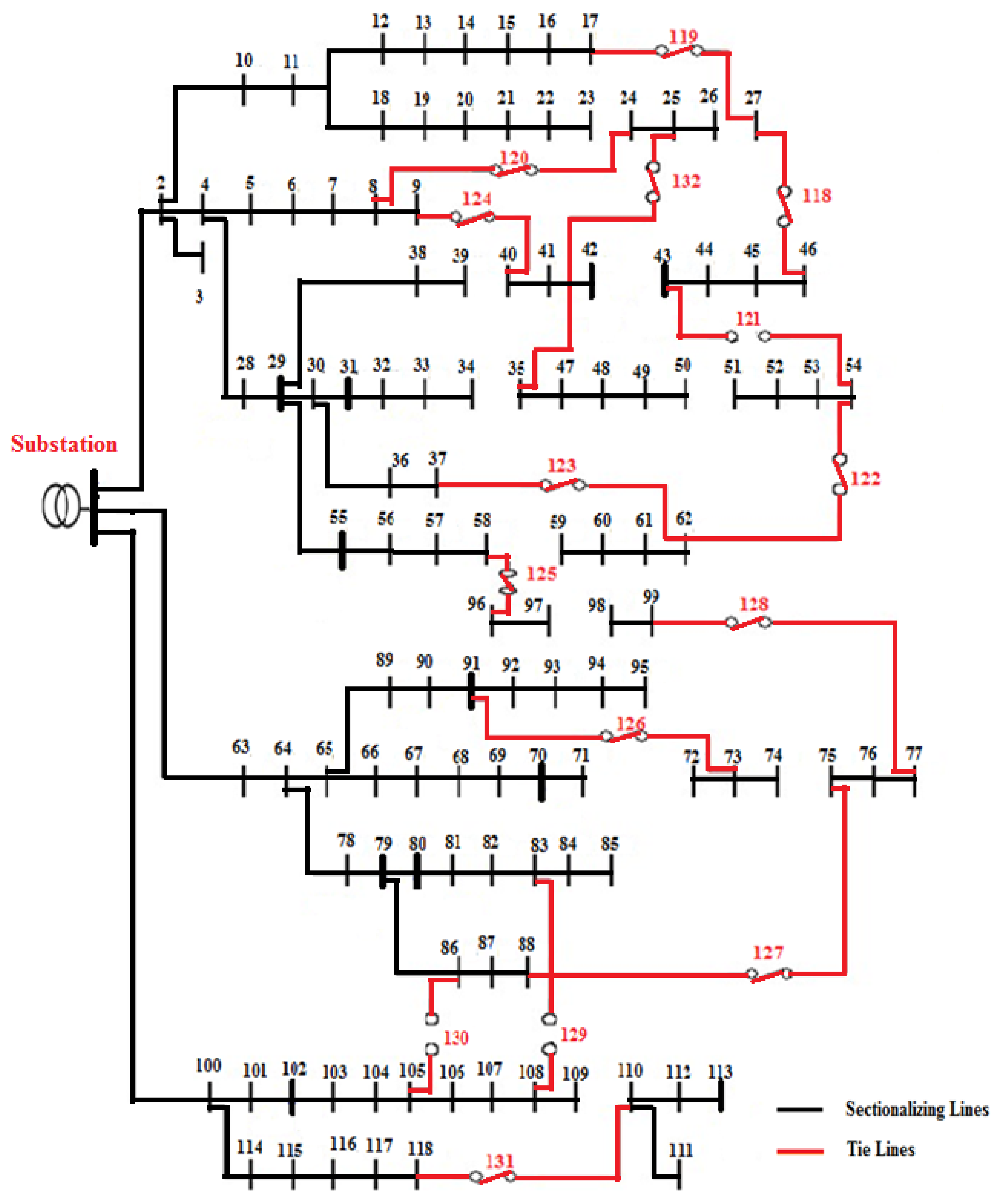
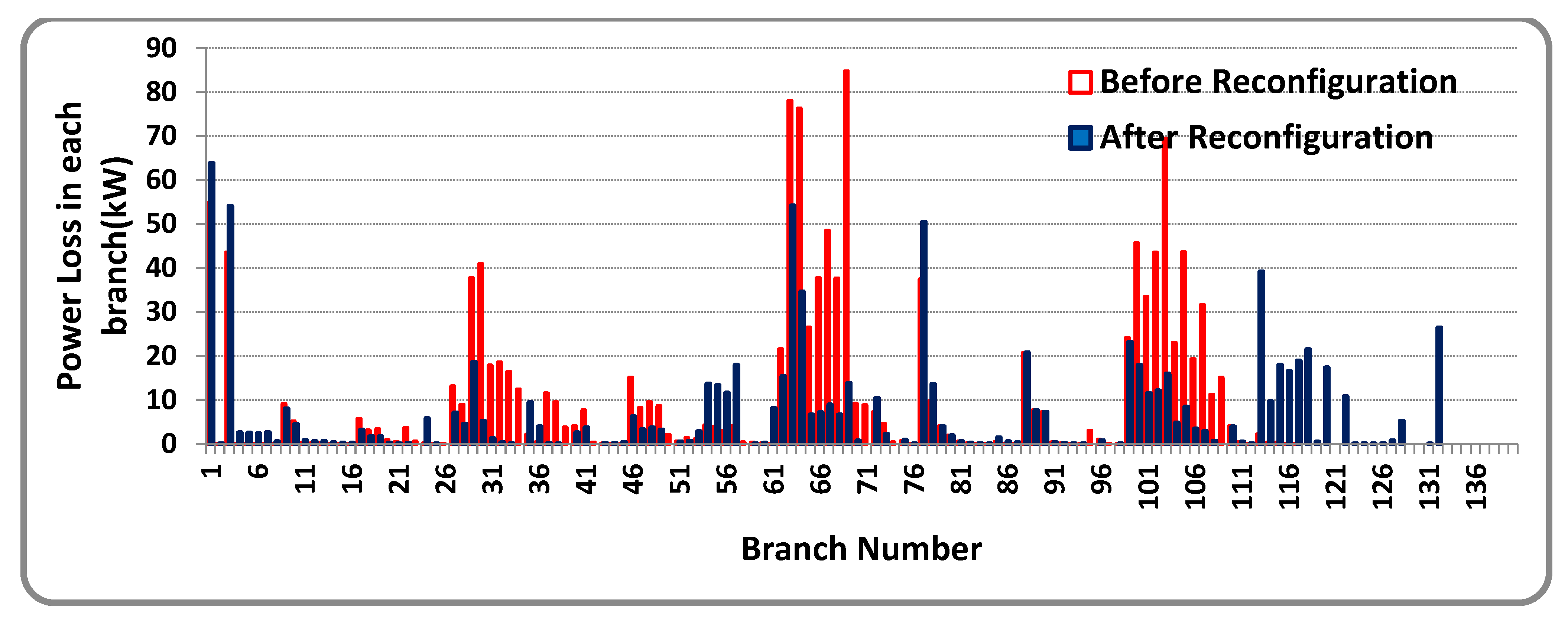
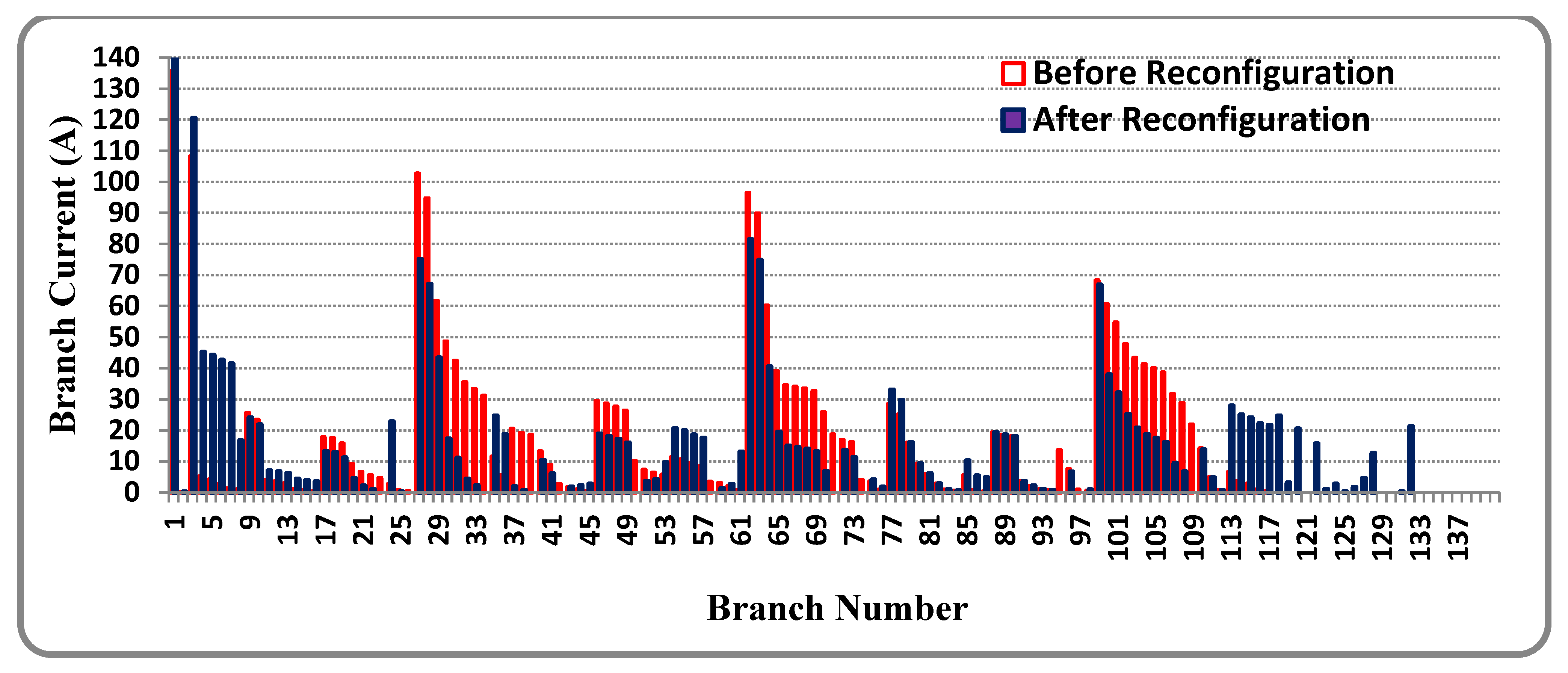
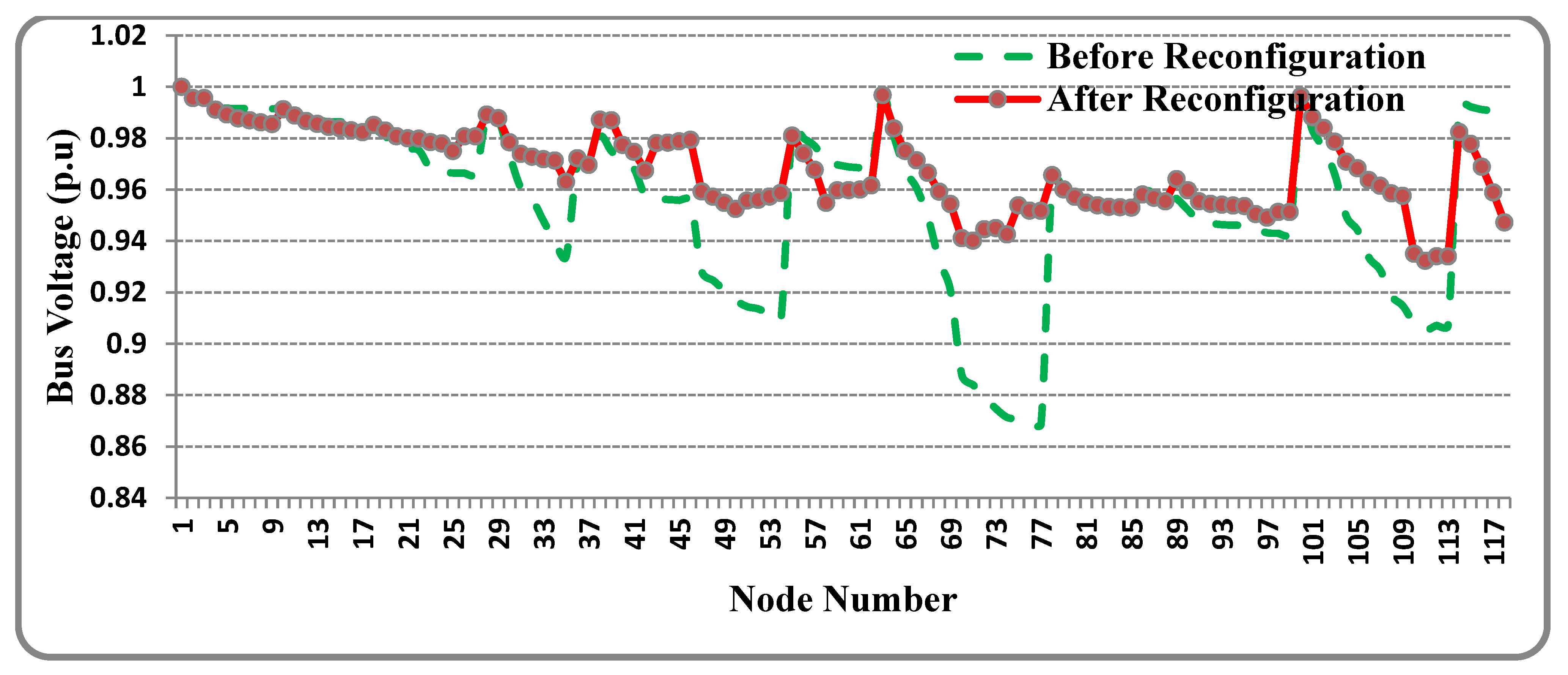
| Scenario | Item | 50% Load | 100% Load | 160% Load |
|---|---|---|---|---|
| Base case radial topology (Scenario-I) | Switches opened (Tie switches) | 118-119-120-121-122-123-124-125-126-127-128-129-130-131-132 | 118-119-120-121-122-123-124-125-126-127-128-129-130-131-132 | 118-119-120-121-122-123-124-125-126-127-128-129-130-131-132 |
| Ploss (kW) | 297.15 | 1298.09 | 3799.70 | |
| Vmin (Node) | 0.9385 (77) | 0.8688 (77) | 0.7673 (77) | |
| Optimal radial topology (Scenario-II) | Switches opened | 23-26-34-39-42-50-58-71-74 -95-97-109-121-129-130 | 23-26-34-39-42-50-58-71-74 -95-97-109-121-129-130 | 23-26-34-39-42-50-58-71- 74-95-97-109-121-129-130 |
| Ploss (kW) | 203.48 | 853.44 | 2326.72 | |
| Vmin (Node) | 0.9673 (111) | 0.9323 (111) | 0.8864 (111) | |
| %Loss reduction | 31.52 | 34.25 | 38.76 |
| Method | Open Switches | Total Power Loss (kW) | % Loss Reduction | Vmin (p.u) |
|---|---|---|---|---|
| Base Topology | 119,120,121,122,123,124,125,126,127,128,129,130,131,132, 133 | 1298.09 | - | 0.8688 |
| PSO [12] | 9, 23, 35, 43, 52, 60, 71, 74, 82, 96, 99, 110, 120, 122, 131 | 897.192 | - | 0.9294 |
| GA [15] | 43,120,24,51,49,62,40,126,74,73,77,83,31,110,35 | 885.56 | 31.78 | 0.9321 |
| RGA [15] | 43,27,23,52, 49,62,40,126,74,73,77,83,131,110,33 | 883.13 | 31.97 | 0.9321 |
| ITS [15] | 43,27,24,52, 120,59,40,96,75,72,98,130,131,110,35 | 865.86 | 33.30 | 0.9323 |
| HAS [15] | 43,27,23,53,123,62,125,126,75,72,129,130,131,132,33 | 854.21 | 34.19 | 0.9323 |
| FWA [15] | 43,26,24,122, 51,59,40,96,72,75,98,130,131,110,35 | 854.06 | 34.21 | 0.9323 |
| CSA [12] | 24, 26, 35, 40, 43, 51, 59, 72, 75, 96, 98, 110, 122, 130, 131 | 855.0402 | - | 0.9298 |
| CGA [12] | 24, 26, 35, 40, 43, 51, 59, 72, 75, 96, 98, 110, 122, 130, 131 | 855.0402 | - | 0.9298 |
| Proposed HSA–PABC | 23-26-34-39-42-50-58-71-74 -95-97-109-121-129-130 | 853.44 | 34.25 | 0.9323 |
4.1.3. Tuning parameters of Hybrid HSA—PABC
| S. No. | Parameters | 69 Node RPDN | 118 Node RPDN |
|---|---|---|---|
| 1 | HMS | 30 | 40 |
| 2 | PAR | 0.5 | 0.5 |
| 3 | HMCR | 0.9 | 0.9 |
| 4 | Minimum inertia weight (ωmin) | 0.4 | 0.4 |
| 5 | Acceleration coefficient (C1, C2) | 2.05 | 2.05 |
| 6 | Maximum inertia weight (ωmax) | 0.9 | 0.9 |
| 7 | SBL | 10 | 20 |
| 8 | MCNSpecified | 50 | 50 |
| Test System | 69 Node RPDN | 118 Node RPDN |
|---|---|---|
| Max.Ploss (kW) | 105.2 | 854.91 |
| Min.Ploss (kW) | 98.63 | 853.44 |
| Standard deviation | 2.0265 | 0.55572 |
| Avg. run time (s) | 5.37 | 9.76 |

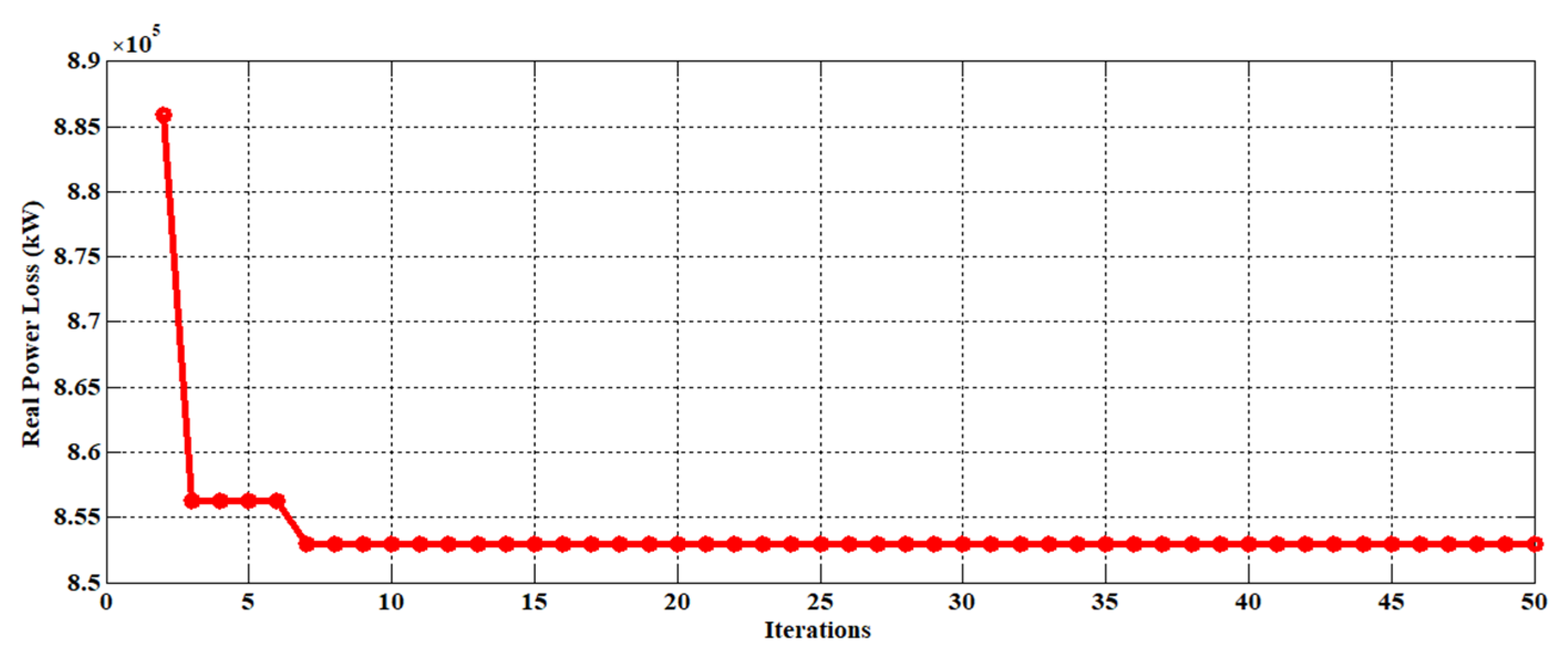
4.2. Performance of the RPDN in the Presence of Solar PV-DG Units and SCs before and after Network Reconfiguration (Scenarios III–VIII)
4.2.1. Performance investigation of 69 node RPDN with the Scenarios III, IV, and V (before Reconfiguration)
| PV-DG Placement before Reconfiguration (Scenario-IV) | |||
|---|---|---|---|
| Item | 50% Load | 100% Load | 160% Load |
| Open switches | 69-70-71-72-73 | ||
| DG rating in KW (Node) | 100 (57), | 100 (57), | 595 (57), |
| 750 (63), | 1536 (63), | 2141 (63), | |
| 119 (22), | 403 (22) | 762 (22) | |
| Total kW injection at each load level | 969 | 2039 | 3498 |
| Ploss (kW) | 18.99 | 75.97 | 198.55 |
| % Loss reduction | 63.19 | 66.23 | 69.57 |
| Vmin@(bus) | 0.9874 (65) | 0.9741 (65) | 0.9557 (65) |
| PV-DG and Capacitor Placement before Reconfiguration (Scenario-V) | |||
|---|---|---|---|
| Item | 50% Load | 100% Load | 160% Load |
| Open switches | 69-70-71-72-73 | ||
| DG rating in KW (Node) | 652 (63) | 1921 (63) | 2422 (63) |
| Multiple × Rating of SC [Switching state: 50%/100%/160%]@Node | 35 × 50 [8/12/35]@17 | ||
| 38 × 50 [12/30/38]@65 | |||
| Total SC rating at each node (kVAR (Node)) | 400 (17), | 600 (17), | 1750 (17), |
| 600 (65) | 1500 (65) | 1900 (65) | |
| Total kVAR injection at each load level | 1000 | 2100 | 3650 |
| Total kW injection at each load level | 652 | 1921 | 2422 |
| Ploss (kW) | 12.79 | 49.95 | 157.34 |
| % Loss reduction | 75.21 | 77.79 | 75.62 |
| Vmin@(bus) | 0.9904 (27) | 0.9821 (27) | 0.9757 (27) |
4.2.2. Performance Investigation of 69 Node RPDN with Scenarios VI, VII, and VIII (after Reconfiguration)
| Capacitor Placement after Reconfiguration (Scenario-VI) | |||
|---|---|---|---|
| Item | 50% Load | 100% Load | 160% Load |
| Open switches | 14-56-61-69-70 | ||
| Multiple × Rating of SC [Switching state: 50%/100%/160%]@Node | 23 × 50 [3/12/23]@17 | ||
| 44 × 50 [10/25/44]@61 | |||
| 10 × 50[2/6/10]@63 | |||
| Total SC rating at each node (kVAR (Node)) | 150 (17) | 600 (17) | 1150 (17) |
| 500 (61) | 1250 (61) | 2200 (61) | |
| 100 (63) | 300 (63) | 500 (63) | |
| Total kVAR injection at each load level | 750 | 2150 | 3850 |
| Ploss (kW) | 16.28 | 71.32 | 198.14 |
| % Loss reduction | 68.44 | 68.30 | 69.63 |
| Vmin (Node) | 0.9834 (61) | 0.9702 (61) | 0.9543 (61) |
| PV-DG Placement after Reconfiguration (Scenario-VII) | |||
|---|---|---|---|
| Item | 50% Load | 100% Load | 160% Load |
| Open switches | 14-56-61-69-70 | ||
| DG rating in KW (Node) | 570 (61), | 1097 (61), | 1701 (61), |
| 100 (62), | 252 (62), | 386 (62) | |
| 50 (17) | 100 (17) | 101 (17) | |
| Total kW injection at each load level | 720 | 1449 | 2188 |
| Ploss (kW) | 10.56 | 42.70 | 115.78 |
| % Loss reduction | 79.53 | 81.02 | 82.25 |
| Vmin (Node) | 0.9876 (61) | 0.9741 (61) | 0.9565 (61) |
| PV-DG and Capacitor Placement after Reconfiguration (Scenario-VIII) | |||
|---|---|---|---|
| Item | 50% Load | 100% Load | 160% Load |
| Open switches | 14-56-61-69-70 | ||
| DG rating in KW (Node) | 676 (60) | 1422 (60) | 2101 (60) |
| Multiple × Rating of SC [Switching state: 50%/100%/160%]@Node | 33 × 50 [10/18/33]@61 | ||
| 41 × 50 [11/23/41]@19 | |||
| Total SC rating at each node (kVAR (Node)) | 500 (61) | 900 (61) | 1650 (61) |
| 550 (19) | 1150 (19) | 2050 (19) | |
| Total kVAR injection at each load level | 1050 | 2050 | 3700 |
| Total kW injection at each load level | 676 | 1422 | 2101 |
| Ploss (kW) | 9.08 | 38.13 | 109.00 |
| % Loss reduction | 82.40 | 83.05 | 83.29 |
| Vmin (Node) | 0.9916 (62) | 0.9836 (62) | 0.9764 (62) |
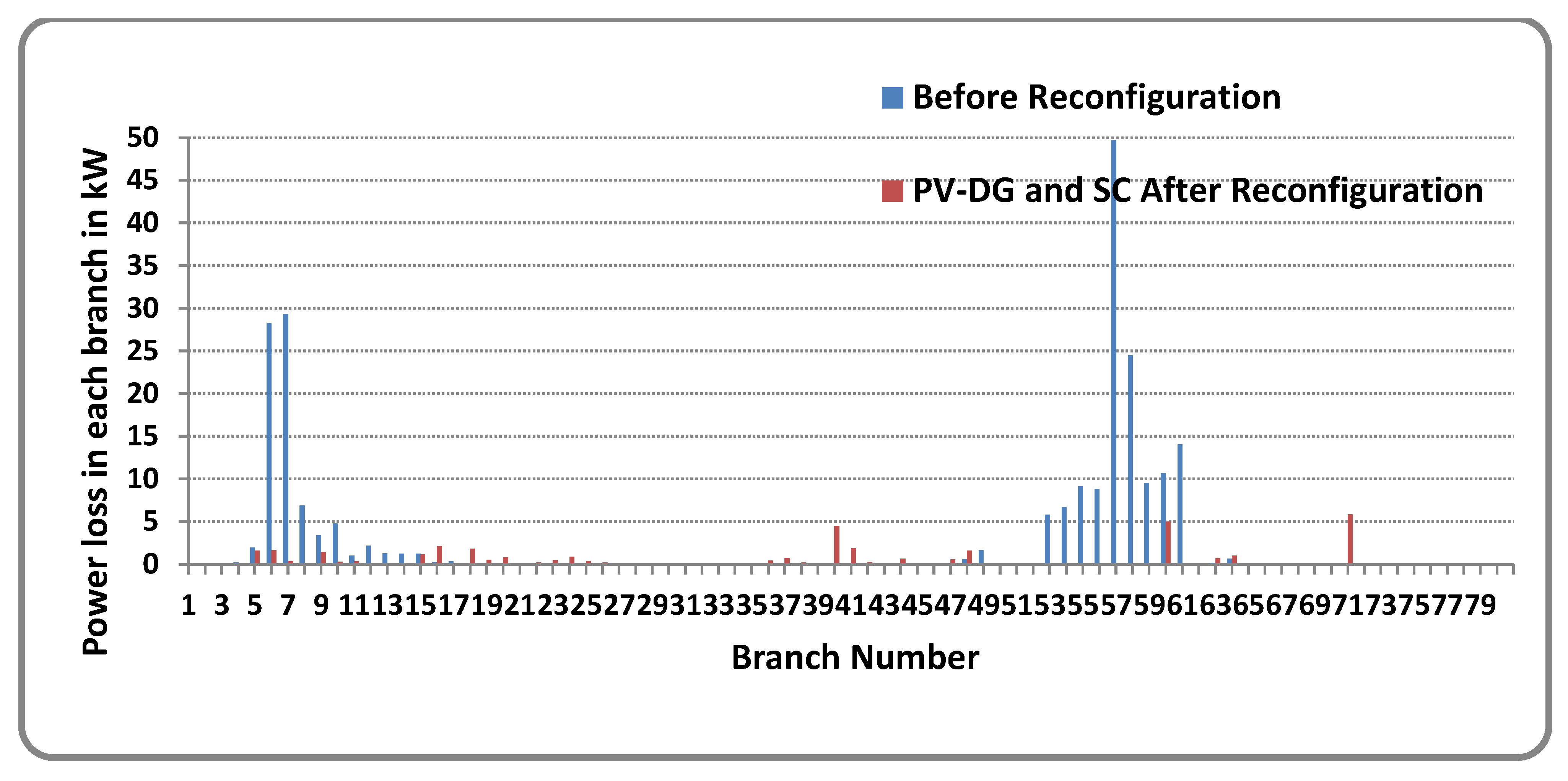
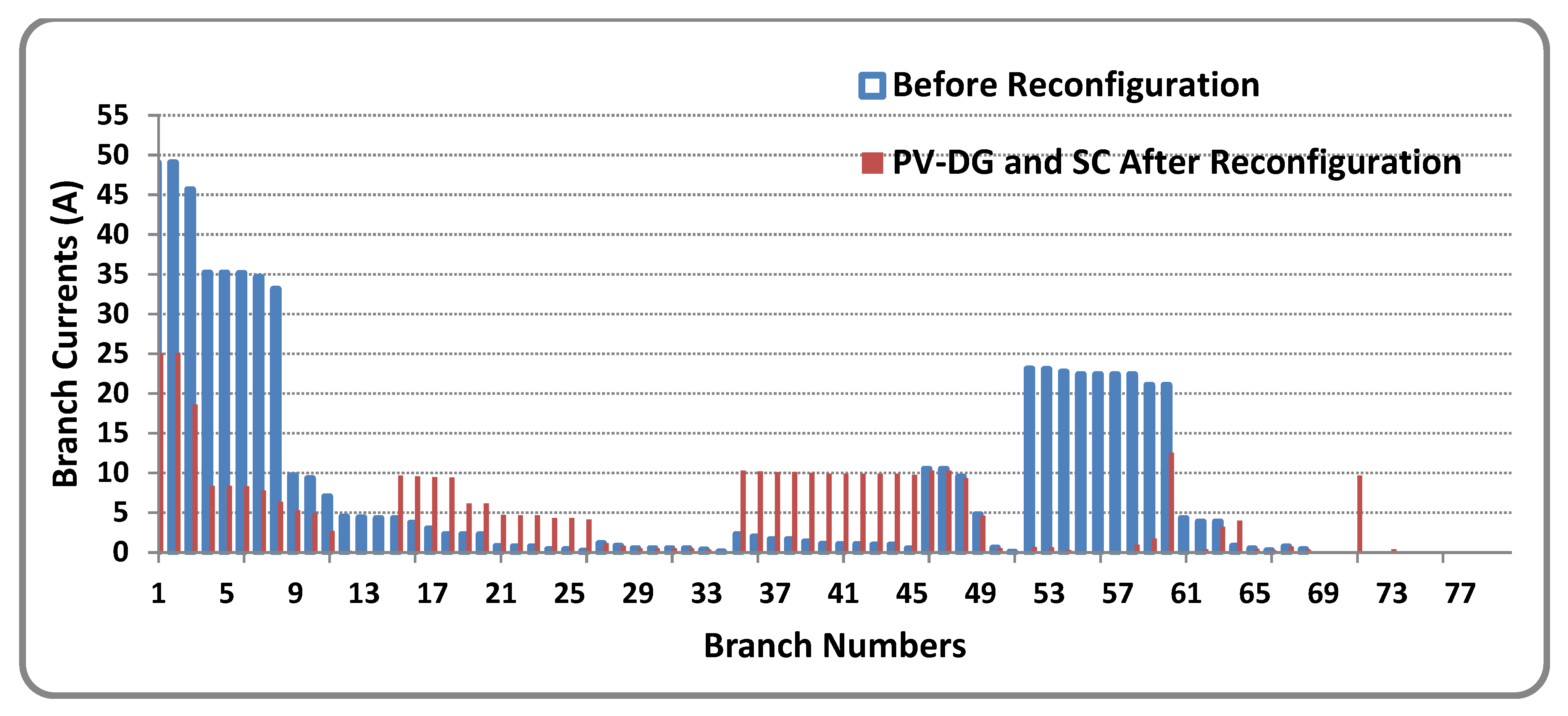
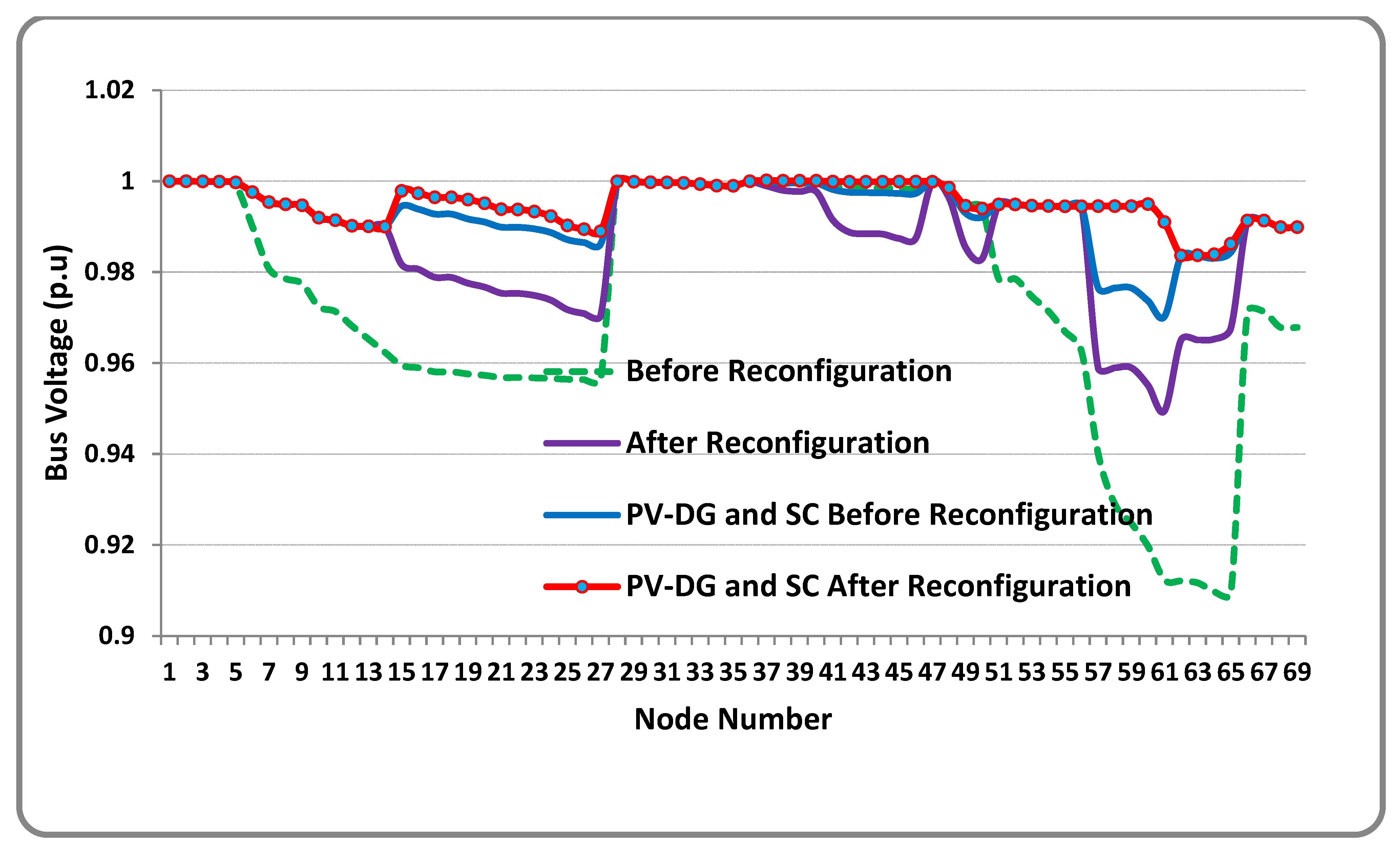
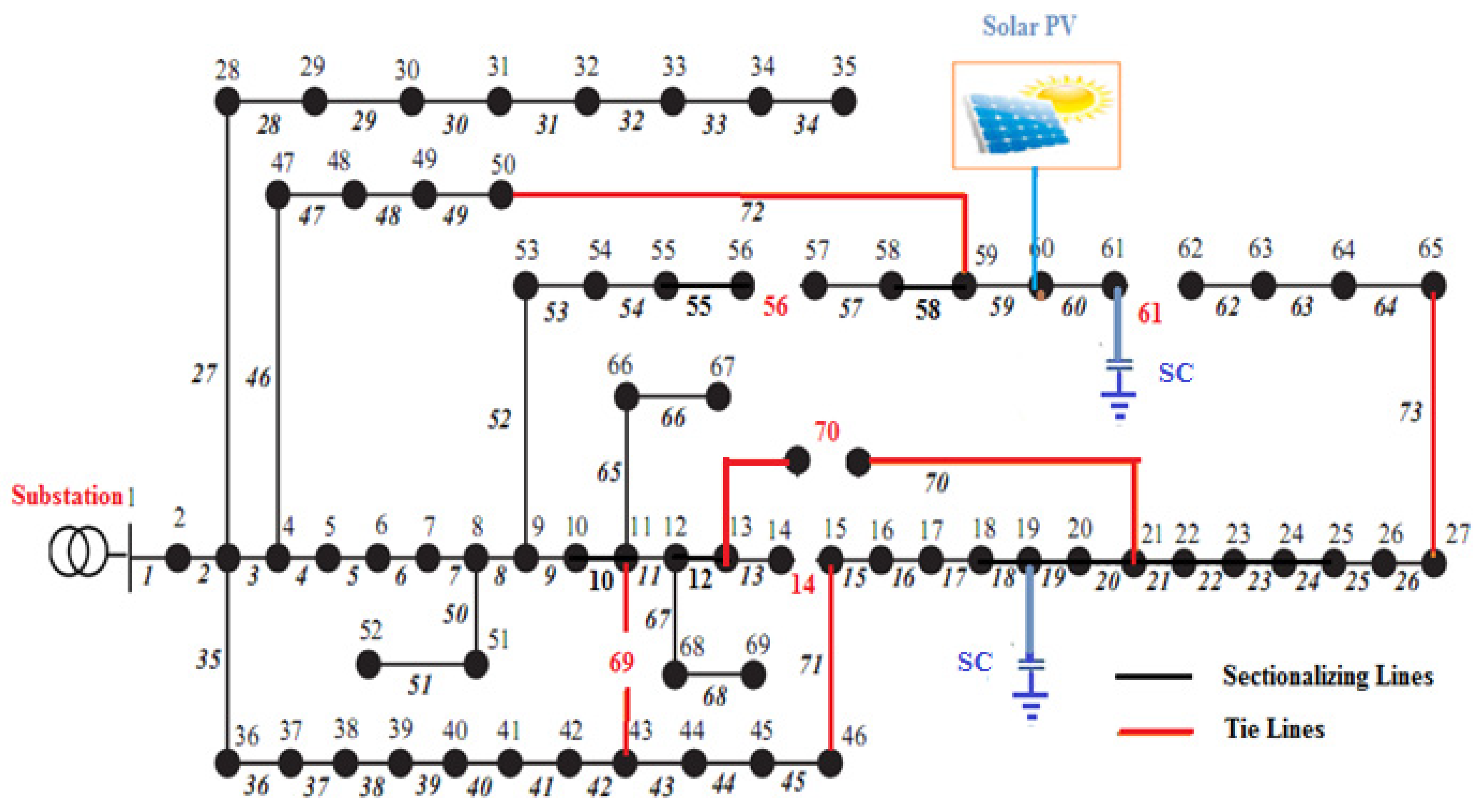
4.2.3. Performance Investigation of 118 Node RPDN with Scenarios III, IV, and V (before Reconfiguration)
| Capacitor Placement before Reconfiguration (Scenario-III) | |||
|---|---|---|---|
| Item | 50% Load | 100% Load | 160% Load |
| Open switches | 118-119-120-121-122-123-124-125-126-127-128-129-130-131-132 | ||
| Multiple × Rating of SC [Switching state: 50%/100%/160%]@Node | 23 × 50 [6/8/23]@98 | ||
| 64 × 50 [20/19/64]@51 | |||
| 71 × 50 [16/33/71]@72 | |||
| 70 × 50 [17/36/70]@67 | |||
| 60 × 50 [19/32/60]@33 | |||
| 69 × 50 [20/44/69]@110 | |||
| 17 × 50 [8/17/14]@49 | |||
| 96 × 50 [5/46/96]@47 | |||
| 17 × 50 [6/9/17]@104 | |||
| 12 × 50 [4/12/11]@92 | |||
| Total SC rating at each node (kVAR (Node)) | 300 (98), | 400 (98), | 1150 (98), |
| 1000 (51), | 1950 (51), | 3200 (51), | |
| 800 (72), | 1650 (72), | 3550 (72), | |
| 850 (67), | 1800 (67), | 3500 (67), | |
| 950 (33), | 1600 (33), | 3000 (33), | |
| 1000 (110), | 2200 (110), | 3450 (110), | |
| 400 (49), | 850 (49), | 700 (49), | |
| 250 (47), | 2300 (47), | 4800 (47), | |
| 300 (104), | 450 (104), | 850 (104), | |
| 200 (92) | 600 (92) | 550 (92) | |
| Total kVAR at each load level | 6050 | 13800 | 24750 |
| Ploss (kW) | 215.65 | 990.62 | 2880.24 |
| % Loss reduction | 27.43 | 23.68 | 24.19 |
| Vmin (Node) | 0.9580 (77) | 0.9129 (77) | 0.8697 (77) |
| PV-DG Placement before Reconfiguration (Scenario-IV) | |||
|---|---|---|---|
| Item | 50% Load | 100% Load | 160% Load |
| Open switches | 118-119-120-121-122-123-124-125-126-127-128-129-130-131-132 | ||
| DG rating in KW (Node) | 1076(109), | 2862(109), | 4311 (109), |
| 2015 (35), | 3951 (35), | 6747 (35), | |
| 1661 (72) | 2562 (72) | 4049 (72) | |
| Total kW injection at each load level | 4752 | 9375 | 15107 |
| Ploss (kW) | 169.68 | 683.71 | 1862.49 |
| % Loss reduction | 42.89 | 47.33 | 50.98 |
| Vmin (Node) | 0.9750 (54) | 0.9477 (54) | 0.9152 (77) |
| PV-DG and Capacitor Placement before Reconfiguration (Scenario-V) | |||
|---|---|---|---|
| Item | 50% Load | 100% Load | 160% Load |
| Open switches | 118-119-120-121-122-123-124-125-126-127-128-129-130-131-132 | ||
| DG rating in KW (Node) | 1475 (70) | 3132 (70) | 4859 (70) |
| Multiple × Rating of SC [Switching state: 50%/100%/160%]@Node | 40 × 50 [5/20/40]@33 | ||
| 6 × 50 [2/2/6]@35 | |||
| 40 × 50 [11/21/40]@74 | |||
| 60 × 50 [30/60/60]@104 | |||
| 10 × 50 [7/10/7]@52 | |||
| 54 × 50 [10/30/54]@50 | |||
| 20 × 50 [2/2/20]@96 | |||
| 11 × 50 [10/10/11]@91 | |||
| 30 × 50 [7/30/10]@67 | |||
| 102 × 50 [19/47/102]@110 | |||
| Total SC rating at each load level (kVAR (Node)) | 250 (33), | 1000 (33), | 2000 (33), |
| 100 (35), | 100 (35), | 300 (35), | |
| 550 (74), | 1050 (74), | 2000 (74), | |
| 1500 (104), | 3000 (104), | 3000 (104), | |
| 350 (52), | 500 (52), | 350 (52), | |
| 500 (50), | 1500 (50), | 2700 (50), | |
| 100 (96), | 100 (96), | 1000 (96), | |
| 500 (91), | 500 (91), | 550 (91), | |
| 350 (67), | 1500 (67), | 500 (67), | |
| 950 (110) | 2350 (110) | 5100 (110) | |
| Total kVAR injection at each load level | 5150 | 11600 | 17500 |
| Total kW injection at each load level | 1475 | 3132 | 4859 |
| Ploss (kW) | 159.25 | 679.37 | 1846.45 |
| % Loss reduction | 46.41 | 47.66 | 51.41 |
| Vmin (Node) | 0.9728 (111) | 0.9480 (111) | 0.9154 (111) |
4.2.4. Performance Investigation of 118 Node RPDN with Scenarios VI, VII, and VIII (after Reconfiguration)
| Capacitor Placement after Reconfiguration (Scenario-VI) | |||
|---|---|---|---|
| Item | 50% Load | 100% Load | 160% Load |
| Open switches | 23-26-34-39-42-50-58-71-74-95-97-109-121-129-130 | ||
| Multiple × Rating of SC [Switching state: 50%/100%/160%]@Node | 27 × 50 [5/11/27]@105 | ||
| 11 × 50 [11/5/8]@18 | |||
| 15 × 50 [13/11/15]@5 | |||
| 23 × 50 [5/7/23]@32 | |||
| 18 × 50 [5/11/18]@97 | |||
| 24 × 50 [6/5/24]@112 | |||
| 19 × 50 [5/9/19]@20 | |||
| 19 × 50 [3/13/19]@25 | |||
| 17 × 50 [3/17/17]@90 | |||
| 19 × 50 [5/9/19]@50 | |||
| Total SC rating at each load level (kVAR (Node)) | 250 (105), | 550 (105), | 1350 (105), |
| 550 (18), | 250 (18), | 400 (18), | |
| 650 (5), | 550 (5), | 750 (5), | |
| 250 (32), | 350 (32), | 1150 (32), | |
| 250 (97), | 550 (97), | 900 (97), | |
| 300 (112), | 250 (112), | 1200 (112), | |
| 250 (20), | 450 (20), | 950 (20), | |
| 150 (25), | 650 (25), | 950 (25), | |
| 150 (90), | 850 (90), | 850 (90), | |
| 250 (50) | 450 (50) | 950 (50) | |
| Total kVAR injection at each load level | 3050 | 4900 | 9450 |
| Ploss (kW) | 168.44 | 712.67 | 1832.64 |
| % Loss reduction | 43.31 | 45.09 | 51.76 |
| Vmin (Node) | 0.9713 (71) | 0.9364 (111) | 0.9032 (71) |
| PV-DG Placement after Reconfiguration (Scenario-VII) | |||
|---|---|---|---|
| Item | 50% Load | 100% Load | 160% Load |
| Open switches | 23-26-34-39-42-50-58-71-74-95-97-109-121-129-130 | ||
| DG rating in KW (Node) | 786 (110), | 908 (110), | 2893 (110), |
| 1293 (89) | 3899 (89) | 4342 (89) | |
| 873 (58) | 2082 (58) | 3117 (58) | |
| Total kW injection at each load level | 2952 | 6889 | 10352 |
| Ploss (kW) | 153.84 | 670.37 | 1702.98 |
| % Loss reduction | 48.23 | 48.35 | 55.18 |
| Vmin (Node) | 0.9753 (71) | 0.9538 (71) | 0.9169 (71) |
| PV-DG and Capacitor Placement after Reconfiguration (Scenario-VIII) | |||
|---|---|---|---|
| Item | 50% Load | 100% Load | 160% Load |
| Open switches | 23-26-34-39-42-50-58-71-74-95-97-109-121-129-130 | ||
| DG size in KW@(Node) | 736 (80) | 3567 (80) | 3533 (80) |
| Multiple × Rating of SC [Switching state: 50%/100%/160%]@Node | 31 × 50 [7/13/31]@91 | ||
| 28 × 50 [21/23/28]@29 | |||
| 16 × 50 [6/5/16]@70 | |||
| 45 × 50 [7/18/45]@55 | |||
| 53 × 50 [19/23/53]@102 | |||
| 51 × 50 [17/23/51]@79 | |||
| 10 × 50 [3/6/10]@43 | |||
| 15 × 50 [4/3/15]@42 | |||
| 39 × 50 [16/9/39]@31 | |||
| 29 × 50 [13/19/29]@113 | |||
| Total SC rating at each load level (kVAR (Node)) | 350 (91), | 1000 (91), | 1900 (91), |
| 1050 (29), | 2200 (29), | 2450 (29), | |
| 300 (70), | 550 (70), | 1100 (70), | |
| 350 (55), | 1250 (55), | 2600 (55), | |
| 950 (102), | 2100 (102), | 3600 (102), | |
| 850 (79), | 2000 (79), | 3400 (79), | |
| 150 (43), | 450 (43), | 650 (43), | |
| 200 (42) | 350 (42), | 750 (42), | |
| 800 (31), | 1250 (31), | 2750 (31), | |
| 650 (113) | 1600 (113) | 2100 (113) | |
| Total kVAR injection at each load level | 5650 | 12750 | 21300 |
| Total kW injection at each load level | 736 | 3567 | 3533 |
| Ploss (kW) | 140.79 | 573.92 | 1515.85 |
| % Loss reduction | 52.62 | 55.84 | 60.10 |
| Vmin (Node) | 0.9769 (111) | 0.9541 (50) | 0.9218 (111) |
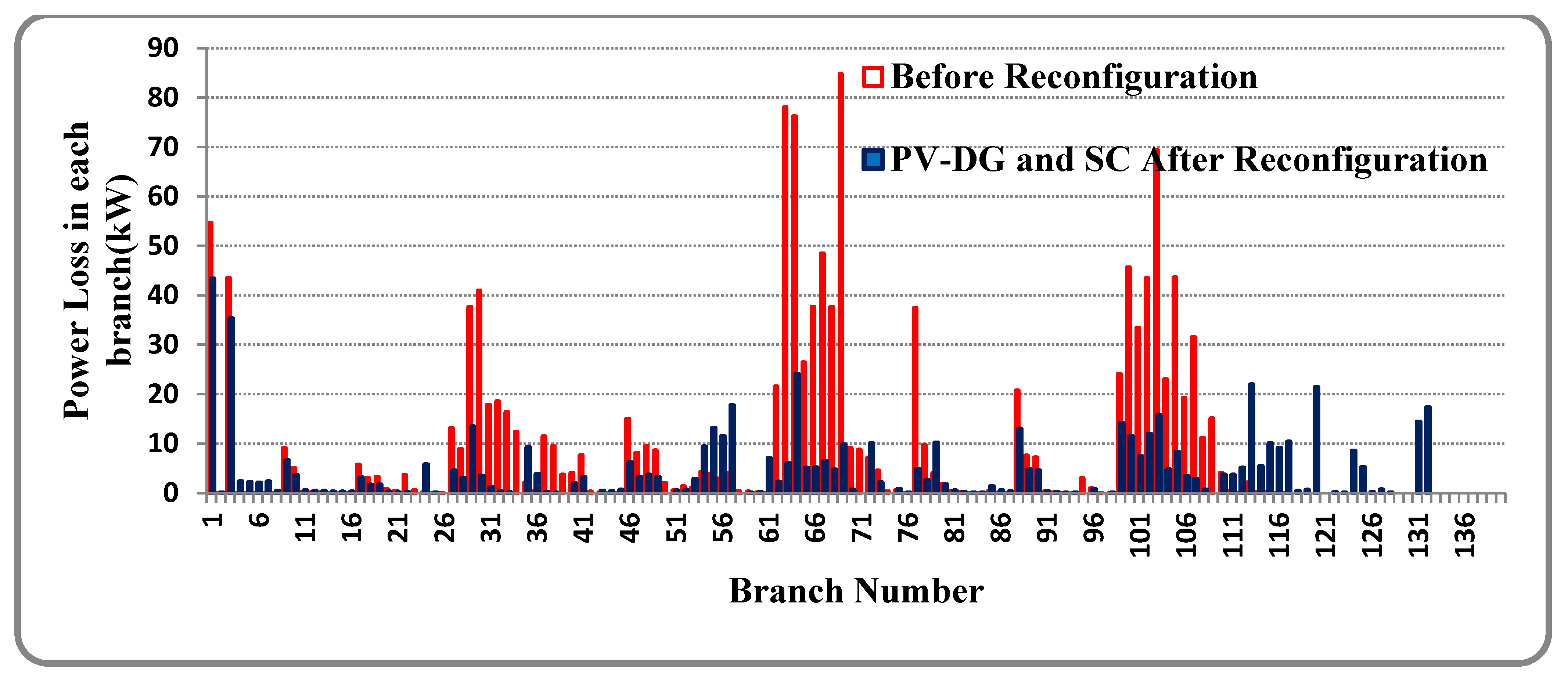

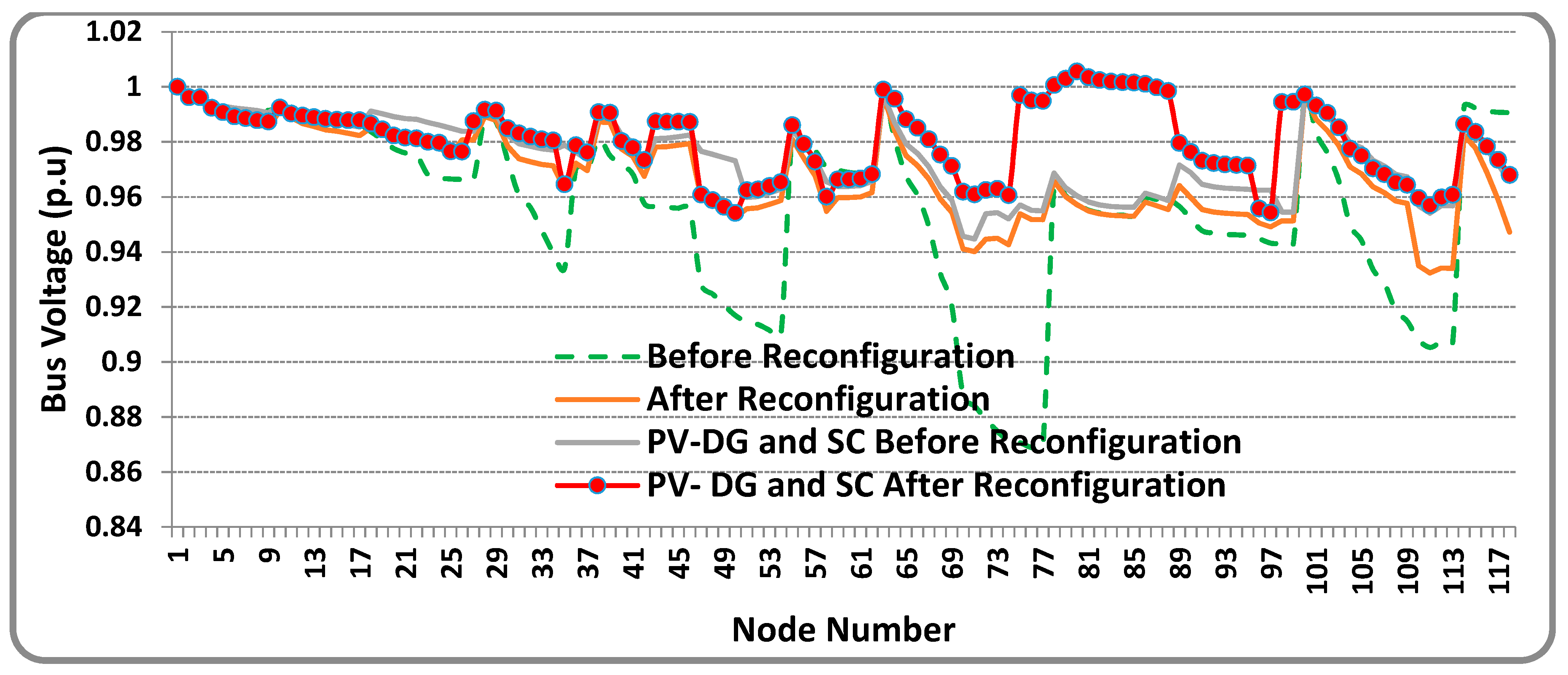
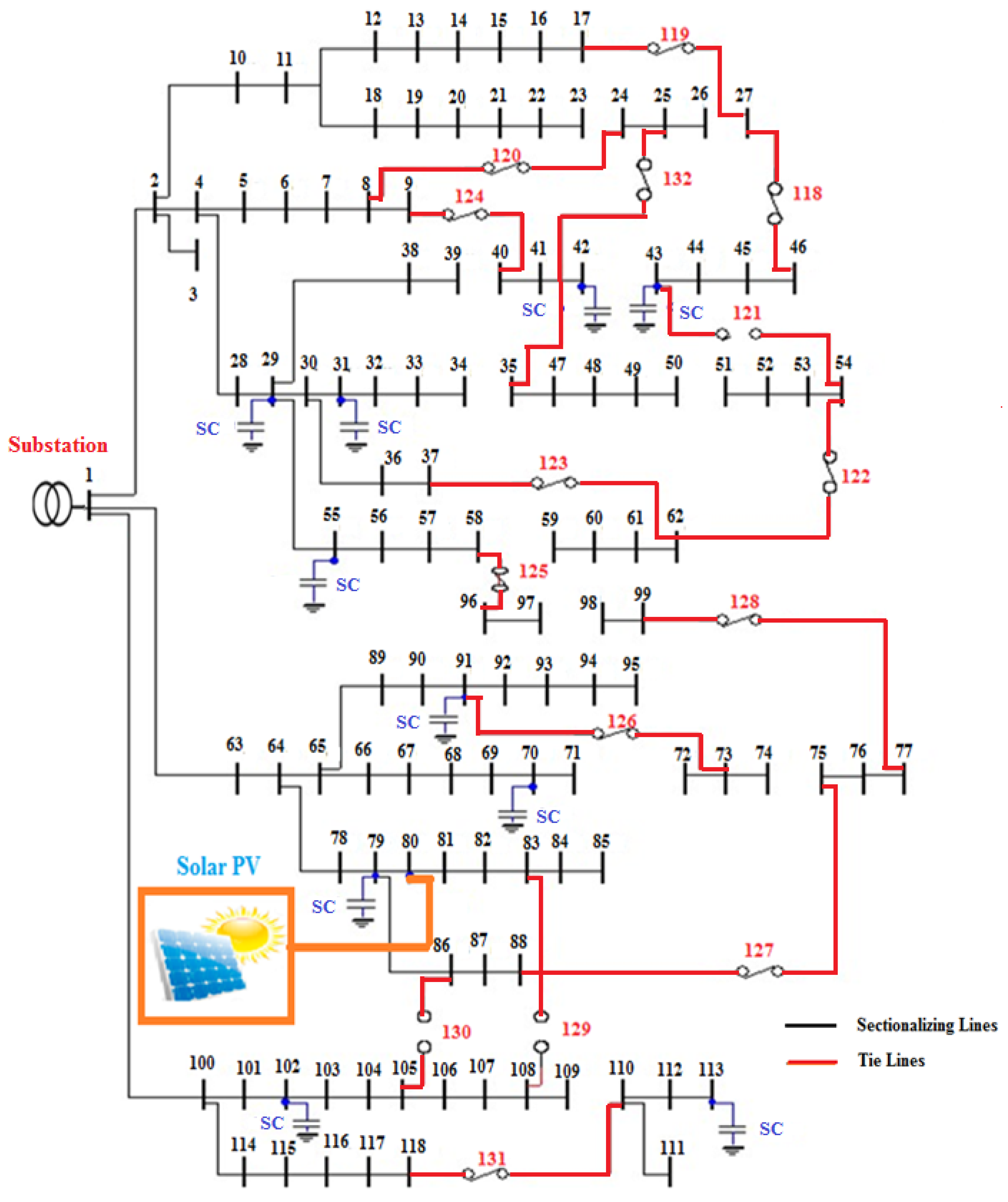
5. Discussion
Technical Perspectives
6. Conclusions
Author Contributions
Funding
Institutional Review Board Statement
Informed Consent Statement
Data Availability Statement
Conflicts of Interest
References
- Baran, M.E.; Wu, F.F. Network reconfiguration in distribution systems for loss reduction and load balancing. IEEE Trans. Power Deliv. 1989, 4, 1401–1407. [Google Scholar] [CrossRef]
- Gohokar, V.; Khedkar, M.; Dhole, G. Formulation of distribution reconfiguration problem using network topology: A generalized approach. Electr. Power Syst. Res. 2004, 69, 304–310. [Google Scholar] [CrossRef]
- Sahoo, N.; Prasad, K. A fuzzy genetic approach for network reconfiguration to enhance voltage stability in radial distribution systems. Energy Convers. Manag. 2006, 47, 3288–3306. [Google Scholar] [CrossRef]
- Raju, G.K.V.; Bijwe, P.R. An Efficient Algorithm for Minimum Loss Reconfiguration of Distribution System Based on Sensitivity and Heuristics. IEEE Trans. Power Syst. 2008, 23, 1280–1287. [Google Scholar] [CrossRef]
- Georgilakis, P.S.; Hatziargyriou, N.D. A review of power distribution planning in the modern power systems era: Models, methods and future research. Electr. Power Syst. Res. 2015, 121, 89–100. [Google Scholar] [CrossRef]
- Naveen, S.; Kumar, K.S.; Rajalakshmi, K. Distribution system reconfiguration for loss minimization using modified bacterial foraging optimization algorithm. Int. J. Electr. Power Energy Syst. 2015, 69, 90–97. [Google Scholar] [CrossRef]
- Chu, C.-C.; Tsai, M.-S. Application of Novel Charged System Search with Real Number String for Distribution System Loss Minimization. IEEE Trans. Power Syst. 2013, 28, 3600–3609. [Google Scholar] [CrossRef]
- Zhang, J.; Yuan, X.; Yuan, Y. A novel genetic algorithm based on all spanning trees of undirected graph for distribution network reconfiguration. J. Mod. Power Syst. Clean Energy 2014, 2, 143–149. [Google Scholar] [CrossRef]
- Arulprakasam, S.; Muthusamy, S. Reconfiguration of distribution networks using rain-fall optimization with non-dominated sorting. Appl. Soft Comput. 2022, 115, 108200. [Google Scholar] [CrossRef]
- Mirhoseini, S.H.; Hosseini, S.M.; Ghanbari, M.; Ahmadi, M. A new improved adaptive imperialist competitive algorithm to solve the reconfiguration problem of distribution systems for loss reduction and voltage profile improvement. Int. J. Electr. Power Energy Syst. 2014, 55, 128–143. [Google Scholar] [CrossRef]
- Rani, D.S.; Subrahmanyam, N.; Sydulu, M. Multi-Objective Invasive Weed Optimization—An application to optimal network reconfiguration in radial distribution systems. Int. J. Electr. Power Energy Syst. 2015, 73, 932–942. [Google Scholar] [CrossRef]
- Nguyen, T.T.; Truong, A.V. Distribution network reconfiguration for power loss minimization and voltage profile improvement using cuckoo search algorithm. Int. J. Electr. Power Energy Syst. 2015, 68, 233–242. [Google Scholar] [CrossRef]
- de Oliveira, L.W.; de Oliveira, E.J.; Gomes, F.V.; Silva, I.C.; Marcato, A.L.; Resende, P.V. Artificial Immune Systems applied to the reconfiguration of electrical power distribution networks for energy loss minimization. Int. J. Electr. Power Energy Syst. 2014, 56, 64–67. [Google Scholar] [CrossRef]
- Kumar, K.S.; Jayabarathi, T. Power system reconfiguration and loss minimization for an distribution systems using bacterial foraging optimization algorithm. Int. J. Electr. Power Energy Syst. 2012, 36, 13–17. [Google Scholar] [CrossRef]
- Imran, A.M.; Kowsalya, M. A new power system reconfiguration scheme for power loss minimization and voltage profile enhancement using Fireworks Algorithm. Int. J. Electr. Power Energy Syst. 2014, 63, 312–322. [Google Scholar] [CrossRef]
- Rao, R.S.; Narasimham, S.V.L.; Raju, M.R.; Rao, A.S. Optimal network reconfiguration of large-scale distribution system using harmony search algorithm. IEEE Trans. Power Syst. 2011, 26, 1080–1088. [Google Scholar] [CrossRef]
- Teimourzadeh, S.; Zare, K. Application of binary group search optimization to distribution network reconfiguration. Int. J. Electr. Power Energy Syst. 2014, 62, 461–468. [Google Scholar] [CrossRef]
- Nguyen, T.T.; Nguyen, T.T.; Truong, A.V.; Nguyen, Q.T.; Phung, T.A. Multi-objective electric distribution network reconfiguration solution using runner-root algorithm. Appl. Soft Comput. 2017, 52, 93–108. [Google Scholar] [CrossRef]
- Lavorato, M.; Franco, J.F.; Rider, M.J.; Romero, R. Imposing radiality constraints in distribution optimization problems. IEEE Trans. Power Syst. 2012, 27, 172–180. [Google Scholar] [CrossRef]
- Iborra, F.L.; Santos, J.R.; Ramos, E.R. Mixed-integer linear programming model for solving reconfiguration Problems in large-scale distribution systems. Electr. Power Syst. Res. 2012, 88, 137–145. [Google Scholar] [CrossRef]
- Mithulananthan, N.; Oo, T.; Van Phu, L. Distributed generator placement in power distribution system using genetic algorithm to reduce losses. Thammasat Int. J. Sci. Technol. 2004, 9, 55–62. [Google Scholar]
- Walling, R.A.; Saint, R.; Dugan, R.C.; Burke, J.; Kojovic, L.A. Summary of Distributed Resources Impact on Power Delivery Systems. IEEE Trans. Power Deliv. 2008, 23, 1636–1644. [Google Scholar] [CrossRef]
- Ng, H.; Salama, M.; Chikhani, A. Classification of Capacitor Allocation Techniques. IEEE Trans. Power Deliv. 2000, 15, 387–392. [Google Scholar] [CrossRef]
- Das, D. Optimal placement of capacitors in radial distribution system using a Fuzzy—GA method. Int. J. Electr. Power Energy Syst. 2008, 30, 361–367. [Google Scholar] [CrossRef]
- Rao, R.S.; Narasimham, S.; Ramalingaraju, M. Optimal capacitor placement in a radial distribution system using Plant Growth Simulation Algorithm. Int. J. Electr. Power Energy Syst. 2011, 33, 1133–1139. [Google Scholar] [CrossRef]
- Tabatabaei, S.; Vahidi, B. Bacterial foraging solution-based fuzzy logic decision for optimal capacitor allocation in radial distribution system. Electr. Power Syst. Res. 2011, 81, 1045–1105. [Google Scholar] [CrossRef]
- El-Fergany, A.A.; Abdelaziz, A.Y. Abdelaziz. Efficient heuristic-based approach for multi-objective capacitor allocation in radial distribution networks. IET Gener. Transm. Distrib. 2014, 8, 70–80. [Google Scholar] [CrossRef]
- El-Fergany, A.; Abdelaziz, A. Artificial Bee Colony Algorithm to Allocate Fixed and Switched Static Shunt Capacitors in Radial Distribution Networks. Electr. Power Compon. Syst. 2014, 42, 427–438. [Google Scholar] [CrossRef]
- El-Khattam, W.; Salama, M. Distributed generation technologies, definitions and benefits. Electr. Power Syst. Res. 2004, 71, 119–128. [Google Scholar] [CrossRef]
- Ackermann, T.; Knyazkin, V. Interaction between distributed generation and the distribution network: Operation aspects. In Proceedings of the IEEE/PES Transmission and Distribution Conference and Exhibition, Yokohama, Japan, 06–10 October 2002; Volume 2, pp. 12–15. [Google Scholar] [CrossRef]
- Ackermann, T.; Andersson, G.; Söder, L. Distributed Generation: A Definition. Electr. Power Syst. Res. 2001, 57, 195–204. [Google Scholar] [CrossRef]
- Hung, D.Q.; Mithulananthan, N. Multiple Distributed Generator Placement in Primary Distribution Networks for Loss Reduction. IEEE Trans. Ind. Electron. 2013, 60, 1700–1708. [Google Scholar] [CrossRef]
- Hung, D.Q.; Mithulananthan, N.; Bansal, R.C. Analytical Expressions for DG Allocation in Primary Distribution Networks. IEEE Trans. Energy Convers. 2010, 25, 814–820. [Google Scholar] [CrossRef]
- AlRashidi, M.; AlHajri, M. Optimal planning of multiple distributed generation sources in distribution networks: A new approach. Energy Convers. Manag. 2011, 52, 3301–3308. [Google Scholar] [CrossRef]
- Chang, C.-F. Reconfiguration and Capacitor Placement for Loss Reduction of Distribution Systems by Ant Colony Search Algorithm. IEEE Trans. Power Syst. 2008, 23, 1747–1755. [Google Scholar] [CrossRef]
- Guimarães, M.; Castro, C.; Romero, R. Distribution systems operation optimisation through reconfiguration and capacitor allocation by a dedicated genetic algorithm. IET Gener. Transm. Distrib. 2010, 4, 1213–1222. [Google Scholar] [CrossRef]
- Farahani, V.; Vahidi, B.; Abyaneh, H.A. Reconfiguration and Capacitor Placement Simultaneously for Energy Loss Reduction Based on an Improved Reconfiguration Method. IEEE Trans. Power Syst. 2012, 27, 587–595. [Google Scholar] [CrossRef]
- Esmaeilian, H.R.; Fadaeinedjad, R. Distribution system efficiency improvement using network reconfiguration and capacitor allocation. Int. J. Electr. Power Energy Syst. 2015, 64, 457–468. [Google Scholar] [CrossRef]
- Sultana, S.; Roy, P.K. Oppositional krill herd algorithm for optimal location of capacitor with reconfiguration in radial distribution system. Int. J. Electr. Power Energy Syst. 2016, 74, 78–90. [Google Scholar] [CrossRef]
- Zidan, A.; Shaaban, M.; El-Saadany, E.F. Long-term multi-objective distribution network planning by DG allocation and feeders reconfiguration. Electr. Power Syst. Res. 2013, 105, 95–104. [Google Scholar] [CrossRef]
- Muthukumar, K.; Jayalalitha, S. Integrated Approach of Network Reconfiguration with Distributed Generation and Shunt Capacitors Placement for Power Loss Minimization in Radial Distribution Networks. Appl. Soft Comput. 2017, 52, 1262–1284. [Google Scholar] [CrossRef]
- Muthukumar, K.; Jayalalitha, S. Optimal Placement and Sizing of Distributed Generators and Shunt Capacitors for Power Loss Minimization in Radial Distribution Networks Using Hybrid Heuristic Search Optimization Technique. Int. J. Electr. Power Energy Syst. 2016, 78, 299–319. [Google Scholar] [CrossRef]
- Muthukumar, K.; Jayalalitha, S. Multiobjective Hybrid Evolutionary Approach for Optimal Planning of Shunt Capacitors in Radial Distribution Systems with Load Models. Ain Shams Eng. J. 2018, 9, 1975–1988. [Google Scholar] [CrossRef]
- Abu-Mouti, F.; El-Hawary, M. Heuristic curve-fitted technique for distributed generation optimisation in radial distribution feeder systems. IET Gener. Transm. Distrib. 2011, 5, 172–180. [Google Scholar] [CrossRef]
- Pepermans, G.; Driesen, J.; Haeseldonckx, D.; Belmans, R.; D’haeseleer, W. Distributed generation: Definition, benefits and issues. Energy Policy 2005, 33, 787–798. [Google Scholar] [CrossRef]
- Photovoltaics Dispersed Generation. IEEE Application Guide for IEEE Std. 1547, IEEE Standard for Interconnecting Distributed Resources with Electric Power Systems; IEEE: Piscataway, NJ, USA, 2009. [Google Scholar]
- Kersting, W.; Dugan, R. Recommended practices for distribution system analysis. In Proceedings of the IEEE PES Power Systems Conference and Exposition, Atlanta, GA, USA, 29 October–1 November 2006; pp. 499–504. [Google Scholar] [CrossRef]
- Barker, P.P.; De Mello, R.W. Determining the impact of distributed generation on power systems. I. Radial distribution systems. In Proceedings of the IEEE Conference on Power Engineering Society Summer Meeting, Seattle, WA, USA, 16–20 July 2000; pp. 1645–1656. [Google Scholar] [CrossRef]
- Teng, J.H. A Network-Topology-based Three-Phase Load Flow for Distribution Systems. Proceeding of National Science. Proc. Nat. Sci. Counc. Roc. 2000, 24, 259–264. [Google Scholar] [CrossRef]
- Geem, Z.W.; Kim, J.H.; Loganathan, G.V. A New Heuristic Optimization Algorithm: Harmony Search. J. Simul. 2001, 76, 60–68. [Google Scholar] [CrossRef]
- Lee, K.S.; Geem, Z.W.; Lee, S.-H.; Bae, K.-W. The harmony search heuristic algorithm for discrete structural optimization. J. Eng. Optim. 2005, 37, 663–684. [Google Scholar] [CrossRef]
- Savier, J.S.; Das, D. Impact of network reconfiguration on loss allocation of radial distribution systems. IEEE Trans. Power Deliv. 2007, 22, 2473–2480. [Google Scholar] [CrossRef]
- Srinivasa Rao, R.; Ravindra, K.; Satish, K.; Narasimham, S.V.L. Power loss minimization in distribution system using network reconfiguration in the presence of distributed generation. IEEE Trans. Power Syst. 2013, 28, 317–325. [Google Scholar] [CrossRef]
- Duan, D.L.; Ling, X.D.; Wu, X.Y.; Zhong, B. Reconfiguration of distribution network for loss reduction and reliability improvement based on an enhanced genetic algorithm. Int. J. Electr. Power Energy Syst. 2015, 64, 88–95. [Google Scholar] [CrossRef]
- Wang, C.; Gao, Y. Determination of power distribution network configuration using non-revisiting genetic algorithm. IEEE Trans. Power Syst. 2013, 28, 3638–3648. [Google Scholar] [CrossRef]
- Gupta, N.; Swarnkar, A.; Niazi, K.R.; Bansal, R.C. Multi-objective reconfiguration of distribution systems using adaptive genetic algorithm in fuzzy framework. IET Gener. Transm. Distrib. 2010, 4, 1288–1298. [Google Scholar] [CrossRef]
- Zhang, D.; Fu, Z.; Zhang, L. An improved TS algorithm for loss minimum reconfiguration in large-scale distribution systems. Electr. Power Syst. Res. 2007, 77, 685–694. [Google Scholar] [CrossRef]
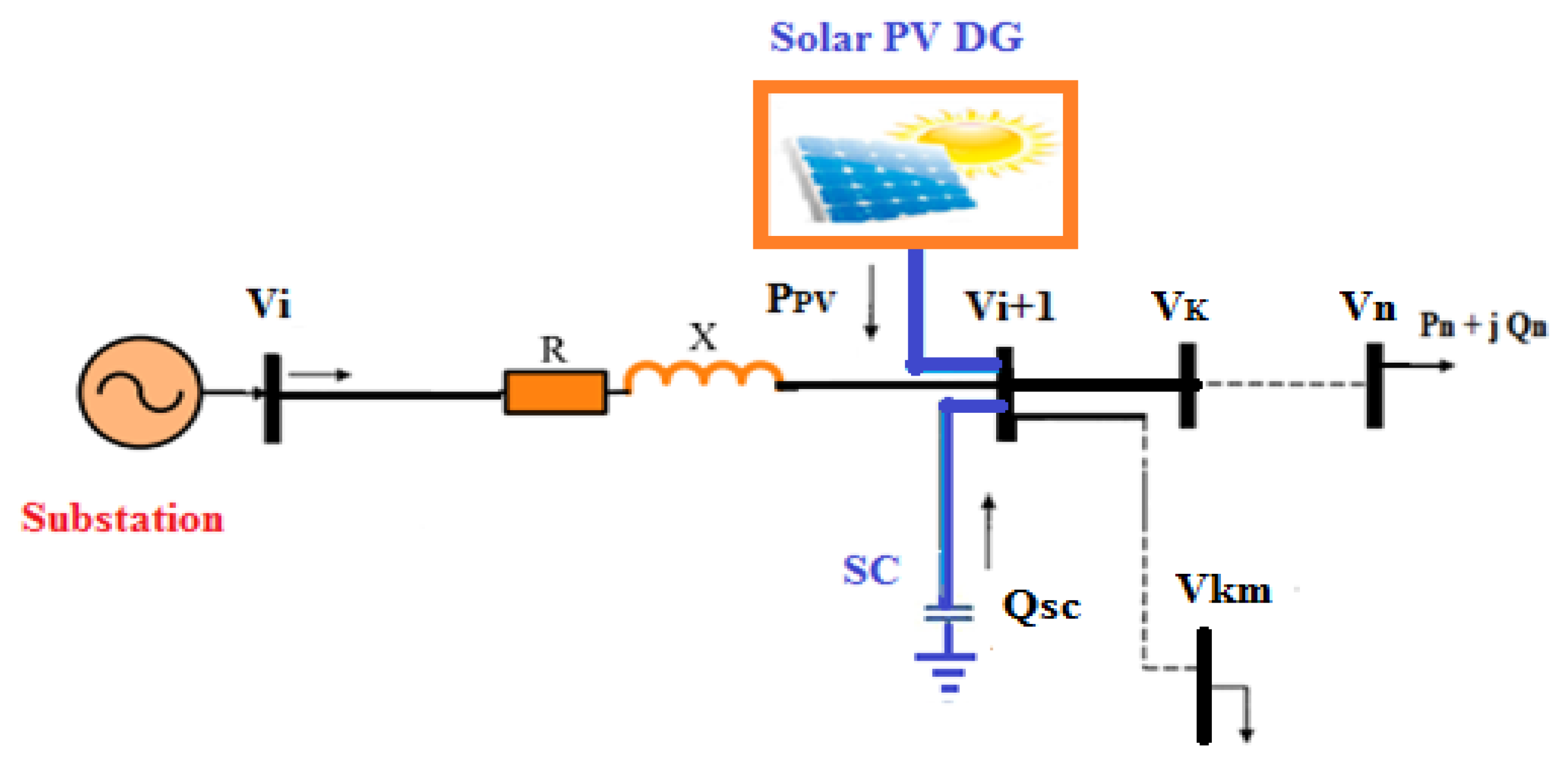

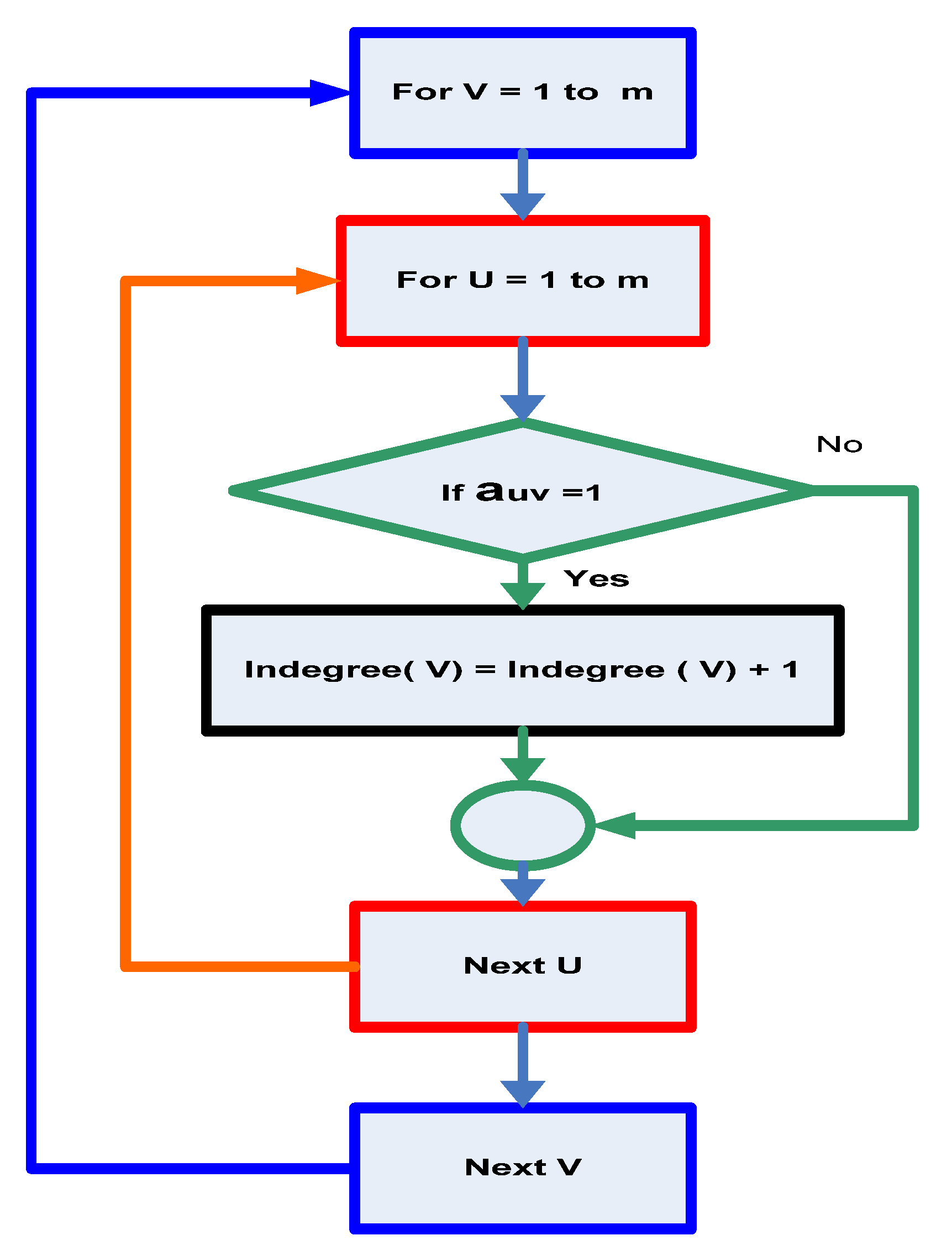
| Items | 69 Node RPDN | 118 Node RPDN |
|---|---|---|
| Nominal voltage (kV) | 12.66 | 11 |
| Active power demand (kW) | 3802.10 | 22,709.7 |
| Reactive power demand (kVAR) | 2694.5 | 17,041.1 |
| Number of branches | 73 | 132 |
| Number of sectionalizing switches (closed) | 1–68 | 1–117 |
| Open switches (Tie switches) | (69-70-71-72-73) | (118-119-120-121-122-123-124-125-126-127-128-129-130-131-132) |
| Capacitor Placement before Reconfiguration (Scenario-III) | |||
|---|---|---|---|
| Item | 50% Load | 100% Load | 160% Load |
| Open switches | 69-70-71-72-73 | ||
| Multiple × Rating of SC [Switching state: 50%/100%/160%]@Node | 15 × 50 [4/9/15]@16 | ||
| 10 × 50 [3/6/10]@22 | |||
| 59 × 50 [17/34/59]@62 | |||
| Total SC rating at each node (kVAR (Node)) | 200 (16), | 450 (16), | 750 (16), |
| 150 (22), | 300 (22), | 500 (22), | |
| 850 (62) | 1700 (62) | 2950 (62) | |
| Total kVAR injection at each load level | 1200 | 2450 | 4200 |
| Ploss | 38.02 | 162.79 | 471.21 |
| % Loss reduction | 26.30 | 27.64 | 27.77 |
| Vmin (Node) | 0.9706(65) | 0.9390 (65) | 0.9005(65) |
Publisher’s Note: MDPI stays neutral with regard to jurisdictional claims in published maps and institutional affiliations. |
© 2022 by the authors. Licensee MDPI, Basel, Switzerland. This article is an open access article distributed under the terms and conditions of the Creative Commons Attribution (CC BY) license (https://creativecommons.org/licenses/by/4.0/).
Share and Cite
Kandasamy, M.; Thangavel, R.; Arumugam, T.; Jayaram, J.; Kim, W.-W.; Geem, Z.W. Performance Enhancement of Radial Power Distribution Networks Using Network Reconfiguration and Optimal Planning of Solar Photovoltaic-Based Distributed Generation and Shunt Capacitors. Sustainability 2022, 14, 11480. https://doi.org/10.3390/su141811480
Kandasamy M, Thangavel R, Arumugam T, Jayaram J, Kim W-W, Geem ZW. Performance Enhancement of Radial Power Distribution Networks Using Network Reconfiguration and Optimal Planning of Solar Photovoltaic-Based Distributed Generation and Shunt Capacitors. Sustainability. 2022; 14(18):11480. https://doi.org/10.3390/su141811480
Chicago/Turabian StyleKandasamy, Muthukumar, Renugadevi Thangavel, Thamaraiselvi Arumugam, Jayachandran Jayaram, Wook-Won Kim, and Zong Woo Geem. 2022. "Performance Enhancement of Radial Power Distribution Networks Using Network Reconfiguration and Optimal Planning of Solar Photovoltaic-Based Distributed Generation and Shunt Capacitors" Sustainability 14, no. 18: 11480. https://doi.org/10.3390/su141811480
APA StyleKandasamy, M., Thangavel, R., Arumugam, T., Jayaram, J., Kim, W.-W., & Geem, Z. W. (2022). Performance Enhancement of Radial Power Distribution Networks Using Network Reconfiguration and Optimal Planning of Solar Photovoltaic-Based Distributed Generation and Shunt Capacitors. Sustainability, 14(18), 11480. https://doi.org/10.3390/su141811480







